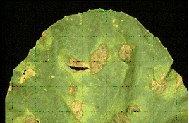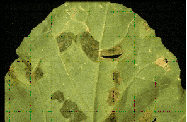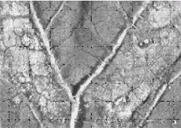Reports on Plant Diseases |
| RPD No. 927 -
Downy Mildew of Cucurbits |
October
1999 |
[ Symptoms
] [ Disease Cycle ] [ Control
]
|
Downy mildew, caused by Pseudoperonospora cubensis, is primarily a disease
of cantaloupe, cucumber, muskmelon, squash, pumpkin, watermelon, gourdes,
and West Indiana gherkin. Citron, calabash, cassaba, and vegetable-marrow
are not commonly attacked, while wild cucumber and related weed hosts
normally escape infection. Only members of the cucumber family (Cucurbitaceae)
become infected. The disease is confined mostly to the leaves, although
the fruit of infected plants may be of poor quality resulting from the
loss of foliage. Downy mildew is most common and destructive during cool,
moist weather. In some years the disease may destroy entire plantings
of susceptible plants.
Symptoms
Symptoms of downy mildew vary with the host and environment. The first
symptom is usually the appearance of indistinct, pale green areas on the
upper leaf surface. In this stage, the disease resembles a mosaic mottling.
The pale green areas soon become yellow in color and angular to irregular
in shape, bounded by the leaf veins (Figure 1). As the disease progresses
the lesions may remain yellow or become brown and necrotic. On some cucurbits
the lesions, as viewed on the upper leaf surface, become reddish brown
to almost black. During moist weather the corresponding lower leaf surface
is covered with a downy, pale gray to purple mildew (Figure 2 and 3).
This mildew is made up of large numbers of sporangiophores bearing tremendous
numbers of microscopic, lemon-shaped spores (sporangia). The color of
the mildew ranges from white to near black. Diseased leaves soon wither,
cup upward, and turn brown. Downy mildew usually first infects the older
leaves nearest to the center of the hill. The time of initial infection
will depend on the availability of inoculum and the favorableness of weather
conditions. In rainy, humid weather the disease progresses outward from
the center of the vine until the entire vine is killed, or only the youngest
leaves at the runner tips remain alive. Downy mildew may spread so rapidly
that affected vines appear to be frosted. Fruit formed on severely infected
plants commonly remain dwarfed and have poor flavor. With the loss of
foliage, fruit can become sunscalded.
Back to Top
|

Figure 1.
Downy mildew on upper leaf surface of pumpkin.

Figure 2.
Downy mildew on lower
leaf surface of pumpkin.
|
|

Figure 3.
Close-up of downy mildew on the lower surface of a muskmelon leaf. (Courtesy
Purdue University)
|
Disease Cycle
Primary infections in the field or garden generally come from sporangia
(spores) produced on southern-grown crops and carried progressively
northward on moist air currents during the spring and summer. The lemon-shaped
sporangia are borne on the gracefully curved and pointed tips of branched
sporangiophores (Figure 4). The sporangia are disseminated locally from
plant to plant and from field to field by splashing rains, moist air
currents, insects, tools, farm equipment, the clothing of workers, and
through the handling of infected plants. Heavy dews, fogs, frequent
rains, and high humidity favor infection and rapid multiplication of
the pathogen.
When a film of moisture is present on a leaf surface, the sporangia
germinate and give rise to motile spores (zoospores) which swim about
for a while before they encyst and produce germ tubes that penetrate
cucurbit leaves. Infection on cucumber leaves can occur following dew
periods of 2 hours at 68 F (20 C), 6 hours at 59 to 68 F (15 to 20 C),
12 hours at 50 to 59 F (10 to 15 C), and 24 hours at 41 to 50 F (5 to
10 C).
Sporangia are produced in greatest numbers at daytime temperatures
of 59 to 68 F (15 to 20 C) and night time temperature of 59 F (15 C).
The minimum time for sporangia to be formed on lesions is 6 hours at
the optimum temperature of 59 to 68 F with 70 percent of the sporangia
produced within 12 hours at this temperature range. Most mature sporangia
are released into the air between 6:00 a.m. and 12 noon with the maximum
at about 8:00 a.m. The infectivity of sporangia decreases when the temperature
is high after being dispersed. The sporangia survive longer at 41 to
63 F (5 to 17 C) than at 75 to 86 F (24 to 30 C). The sporangia must
remain wet until they germinate or they die.
Once infection occurs a new crop of sporangia are produced in 4 to
12 days, depending on temperature and day length. Because cucurbit plantings
can become diseased so rapidly and severely, the symptoms are often
mistaken for frost damage. Temperature is not as critical as it is with
many other vegetable diseases. Infection may occur over the relatively
wide temperature range of 41 to 86 F (5 to 30 C), the optimum being
61 to 72 F (16 to 22 C). Extended periods of hot, dry weather tend to
inhibit the spread of the disease.
Five pathotypes have been described for P. cubensis. All described
pathotypes infect susceptible cucumber and netted melon cultivars, but
are not compatible with watermelon, squash, or pumpkin. This explains
why cucumber and netted melons are sometimes heavily infected, while
nearby watermelon, squash, or pumpkin are not affected.
The downy mildew pathogen does not overwinter in plant debris in Illinois.
The pathogen may overwinter in some areas as thick-walled oospores which
are capable of withstanding extremes in temperature and dryness. It
is not clear if these oospores play any role in disease development.
Back to Top
|
|
Control
1. Whenever possible plant varieties that are resistant to downy mildew.
High levels of resistance are available in commercial cucumber varieties.
Lower levels of resistance are available in melon and watermelon. Strain
specific resistance is available in some pumpkin and squash varieties,
so these varieties will be resistant to some strains of the pathogen,
but very susceptible to other strains.
2. Fungicide applications may be necessary on susceptible varieties during
humid weather (61 to 72 F or 16 to 22 C). It is especially important to
get good coverage of the lower leaf surfaces, as infections commonly occur
on the undersides of leaves. Both systemic and protectant fungicides are
available for control of downy mildew. Protectant fungicides are less
effective when used on susceptible varieties or when disease pressure
is heavy. Systemic fungicides should be used in combination with protectant
fungicides to reduce the chance of developing fungicide resistant strains
of the pathogen. Consult the "Midwest Vegetable Production Guide
for Commercial Growers" for use of effective fungicides.
3. Wide spacing between plants, choosing planting sites with good soil
and air drainage and exposure to all-day sun, maintaining ample but not
excessive nitrogen fertility, and control of cucurbit weeds are recommended.
4. Avoiding overhead irrigation or irrigating only in the early morning
hours will limit the amount of time that leaves are wet. This will help
reduce the amount of time in which conditions are favorable for spores
of the pathogen to germinate and infect the plant.
|

Figure 4.
Pseudoperonospora cubensis, the downy mildew pathogen, as it would appear
under a high-power microscope. Note the treelike sporangiophore bearing
the lemon-shaped sporangia (drawing by L. Gray).
|
Back to Top
For further information on downy mildew of cucurbits, refer to the "Compendium
of Cucurbit Diseases," published by the American Phytopathological Society,
St. Paul, Minnesota.
The above mentioned publications are available from University of Illinois
Ag Services, P345, 1917 South Wright St., Champaign, IL 61820 (1-800-345-6087).
Back to Top
|



